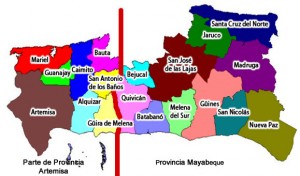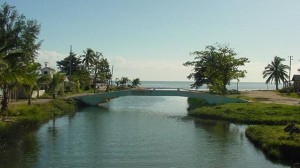 In 1977, on applying the political-administrative division that increased the provinces of the country to fourteen, the capital was divided into two: Havana City, with 15 municipalities, and Havana, with 19 — two of which came from Pinar del Rio — and which was then subtracted from to create Artemis and Mariel. Thirty-three years later, instead of returning to the old six provinces and adjust the bureaucratic octopus to the socioeconomic involution of the island, someone decided to multiply again.
In 1977, on applying the political-administrative division that increased the provinces of the country to fourteen, the capital was divided into two: Havana City, with 15 municipalities, and Havana, with 19 — two of which came from Pinar del Rio — and which was then subtracted from to create Artemis and Mariel. Thirty-three years later, instead of returning to the old six provinces and adjust the bureaucratic octopus to the socioeconomic involution of the island, someone decided to multiply again.
The national territory is the same, but as of January 2011 we have 15 instead of 14 provinces, plus the Isle of Youth, as special municipality. The increase is due to the division into two provinces of Havana: Artemis and Mayabeque. The City of Havana returns to Havana, a reduced Havana and its two twin daughters, the first of which we have added three municipalities of Pinar del Rio: Bahia Honda, Candelaria and San Cristobal.
Since almost nobody understands the reason for the bureaucratic and political realignment that increases the number of functionaries and changes people’s hometowns and local boundaries, the official press reports alleged massive adherents, speaks of “geographical consistency,” “material consensus,” the “strong agricultural economy,” theexpectations of improvements in transport and supplies and “identity in motion.” In the case of Mayabeque, it is centered around the river basin which gives it its aboriginal name, whose waters flow through seven towns, from Catalina de Guines to the Gulf of Batabano.
Mayabeque province’s is made up of 11 municipalities with San Jose de las Lajas at the head, which borders the capital as do Bejucal, Jaruco and Santa Cruz del Norte, and Madruga, Quivican Batabano, Melena del Sur, Guines, San Nicholas and Nueva Paz.
The urban centers of each municipality are based in rural and local culture, some with urban pretensions. They are people-islands, surrounded by plains looking into and within Havana as a reference point. They barely have buildable contacts among themselves and lack an articulated system of transport system, although several are crossed by the main road, the national highway or rail links. The greatest economic and cultural role was that of Guines, connected to the capital by rail since 1938, and now relegated San Jose de las Lajas.
Due to its proximity to the main city, San José de las Lajas benefited from industries and agricultural research. It is a small city with only seventy-four thousand inhabitants, without colonial buildings or neoclassical architecture. It differs from Guines and other towns of the eighteenth and nineteenth centuries by the absence of central park with a church, town hall, theater, etc. It is crossed by the Central Road and the train to Havana — Guines, in crisis for decades.
 Except for the fiesta in Bejucel Village — el Parrandas de Bejucal — the Feast of Santa Barbara in Guines, the Mollete Melena del Sur, and the songs repentist poets celebrating the river and the livestock and agricultural traditions of the Havana-Matanzas plane, in the province of Mayabecque the cultural identity awaits the future, as do expectations for development and the dreams of the majority of its overwhelmed people.
Except for the fiesta in Bejucel Village — el Parrandas de Bejucal — the Feast of Santa Barbara in Guines, the Mollete Melena del Sur, and the songs repentist poets celebrating the river and the livestock and agricultural traditions of the Havana-Matanzas plane, in the province of Mayabecque the cultural identity awaits the future, as do expectations for development and the dreams of the majority of its overwhelmed people.
Imagine the uprooting of thousands of people on that first of January 2011 as they learned that they are no longer in Havana.
February 27 2011
